Are you planning your next trip to Italy? Then let me tell you that, if you’re an art lover, you can’t miss the mosaics of Ravenna. This small city in the northeast of the country is maybe not as well known as other Italian destinations, but it will definitely be a nice surprise.
Looking for Ravenna tours? Have a look below!
We always book tours with GetYourGuide – the company offers a variety of activities, flexible booking, and 24/7 support!
- Ravenna: UNESCO Monuments and Mosaics Guided Tour – a best-selling tour of all the best Ravenna mosaics!
- Ravenna: Dining Experience at a Local’s Home – everyone knows that in Italy the best food is in local homes!
- Ravenna: Guided Sightseeing Tour – accompanied by a historian guide
- Ravenna: Walking Tour with Stunning Byzantine Mosaics – discover Ravenna highlights with a local
- Ravenna Walking Tour with Museum Tickets – great value walking tour!
Ravenna may not appear on everyone’s Italy wish list like like Venice or Rome, but it’s well worth a visit during your Italian holiday. You can think of it as a hidden gem that you didn’t know existed, that unveils incredibly precious jewels when you open it.
What are these precious jewels, you may ask. Well, let me tell you – Ravenna’s Byzantine mosaics are surely the most sparkling – they are so spectacular and valuable that they were recognized as World Heritage by UNESCO in 1996.
Isn’t this a good enough reason to include Ravenna in your Northern Italy road trip itinerary?
But don’t think that the art scene of the city is still stuck in the past. You will also find modern mosaics spread around Ravenna’s streets, and hidden in the tiny ateliers of local mosaic artists.
If you’re looking for an off-the-beaten-path adventure in Italy, then Ravenna and its artworks made of colourful tiles are a must.
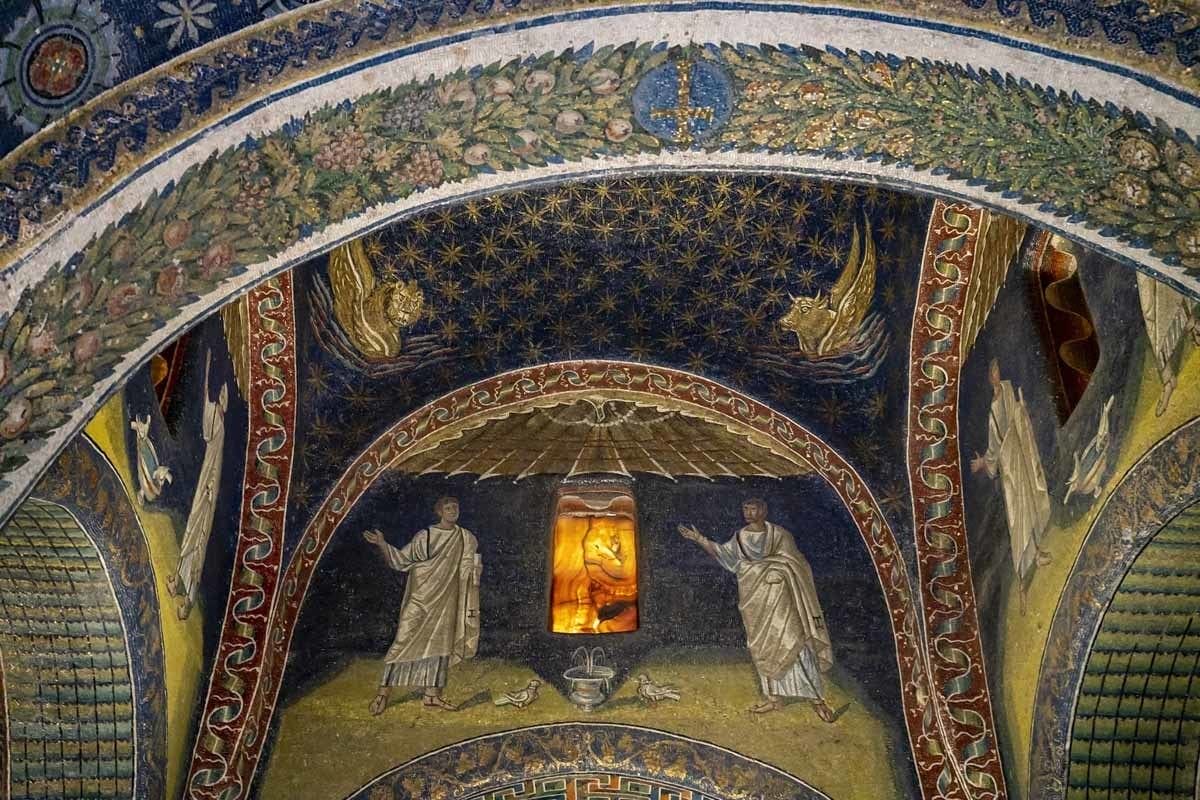
Ravenna in the Past – Historical Notes
Ravenna is a place with a truly prestigious past, even though you may never have heard of the city before. It was in fact a capital – not once, not twice, but actually three times!
The first time it became the capital of the Western Roman Empire in the 5th century AD, then under the reign of Theodoric, king of the Goths, and lastly of the Byzantine Empire in Europe, up until the 8th century AD.
During that period of wealth and prestige, several churches and mausoleums were built all over Ravenna, beautifully decorated with the stunning Byzantine mosaics we can still see today.
The golden heyday of Ravenna ended when the city fell into Lombard hands in the 8th century, then it was conquered by the Franks shortly afterwards, and relegated to the role of provincial town.

However, the history of Ravenna didn’t end there, of course, but it went on throughout the Middle Ages and then into modern times, with Gothic and Baroque influences found all over the city.
Along the centuries, many famous artists and writers fell in love with Ravenna. Do names like George Byron, Gustav Klimt, Oscar Wilde or Herman Hesse ring a bell?
Yet, there’s no poet whose name is remembered in Ravenna more than Dante Alighieri, the author of the Divine Comedy and father of the Italian language, who spent the last three years of his life in Ravenna before dying there in 1321.
You can still visit Dante’s tomb, located in a small neoclassical temple dating back to the 18th century, right next to the Basilica di San Francesco in the city centre.
I’m sure you want to find out what’s so special about Ravenna and its mosaics, now. Am I right?
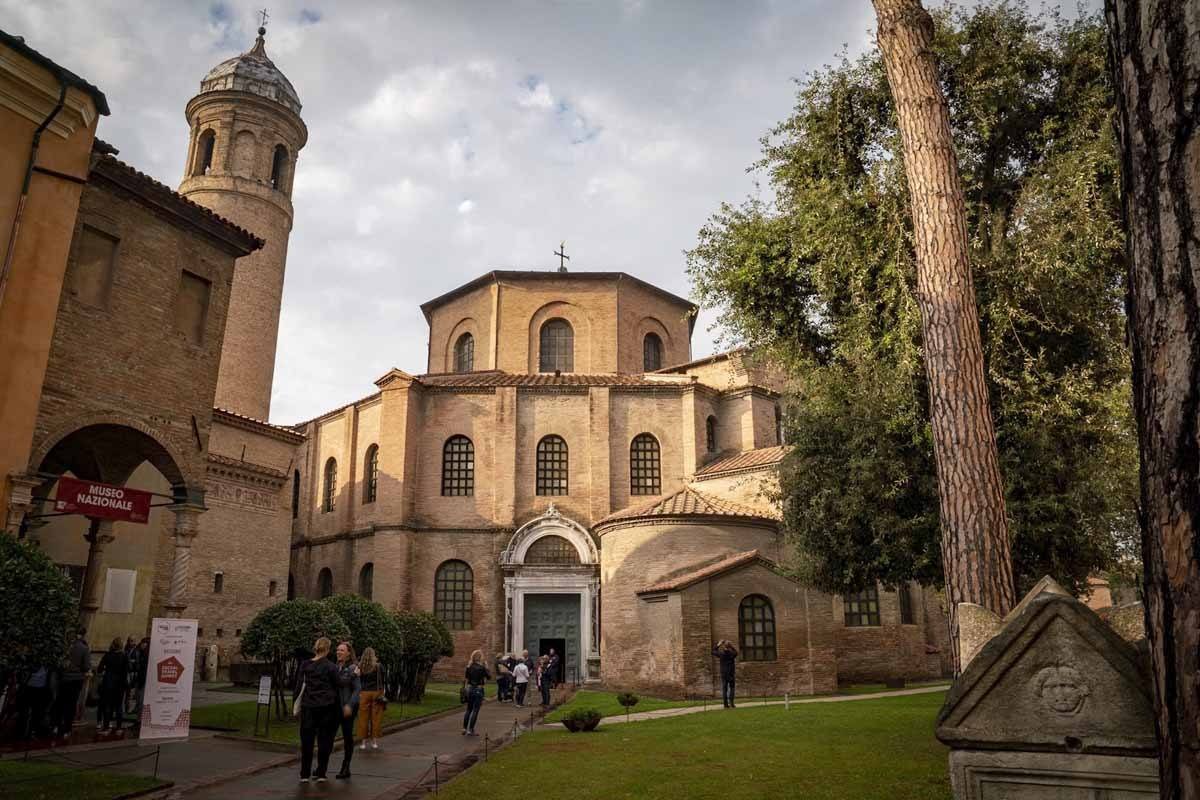
Early Christian and Byzantine Ravenna Mosaics
Around the historic centre and the surroundings of Ravenna, there are quite a few religious buildings decorated with Early Christian and Byzantine mosaics, all of which are listed as UNESCO World Heritage sites.
You can see 5 of the best Ravenna mosaics (specifically, the first 5 listed below) with an inclusive ticket, that you can get at any of those locations.
Other locations require a specific admission ticket that you can purchase on-site.
San Vitale Basilica
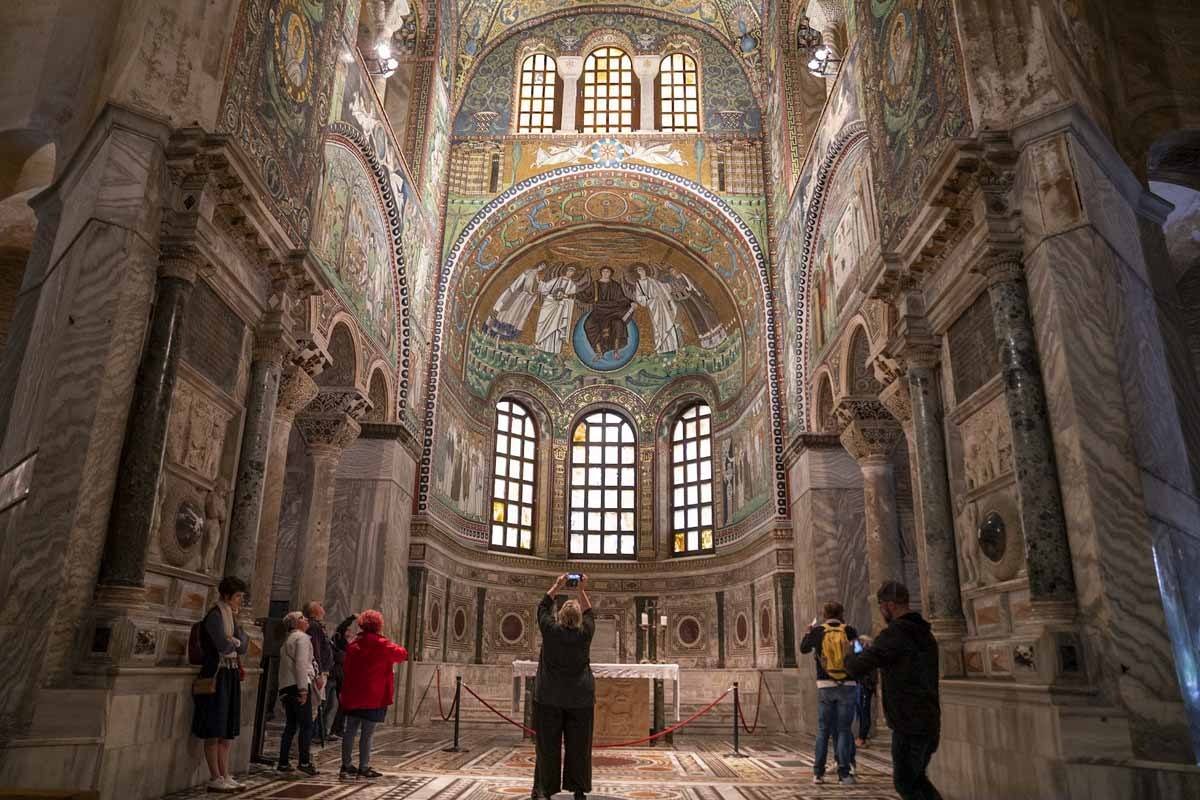
The Basilica of San Vitale is probably the most impressive sight you will see in Ravenna. It’s considered one of the most important examples of Early Christian art in Italy, especially – but not only – for its mosaics.
This basilica represents a perfect mix between Eastern and Western traditions, both through its architecture and the decorations.
San Vitale presents a blend of Roman and Byzantine elements – the former can be seen in the dome, topped by a cupola with Baroque frescoes, and the latter in the shape of the apse, flying buttresses in the exterior, capitals, and octagonal ground plan.
The real marvel of San Vitale are the dazzling Byzantine mosaics that decorate the presbytery and choir. Above the altar, there’s a mosaic depicting Christ the Redeemer, with two angels, San Vitale and a bishop holding a model of the church.
Just below, there are two panels dedicated to the Emperor Justinian and his wife Theodora, both wearing fine capes and jewels. The other mosaics illustrate scenes from the Old Testaments, plus images of the Twelve Apostles and four Evangelists, with the Lamb of God overseeing everything from the top of the vaulted ceiling – representing the divine offering, in contrast with the earthly riches held by the emperor and his wife.
The mosaics of San Vitale have often been described as the best surviving example of Byzantine mosaics outside Istanbul. Gustav Klimt visited the church during his Ravenna visit in 1903, and that sparked the beginning of his Golden Phase, when he produced some of his best known works, like The Kiss and the portrait of Adele Bloch Bauer.
Once you’ll see these amazing Ravenna mosaics, you’ll see where Klimt got his inspiration from!
Mausoleum of Galla Placidia
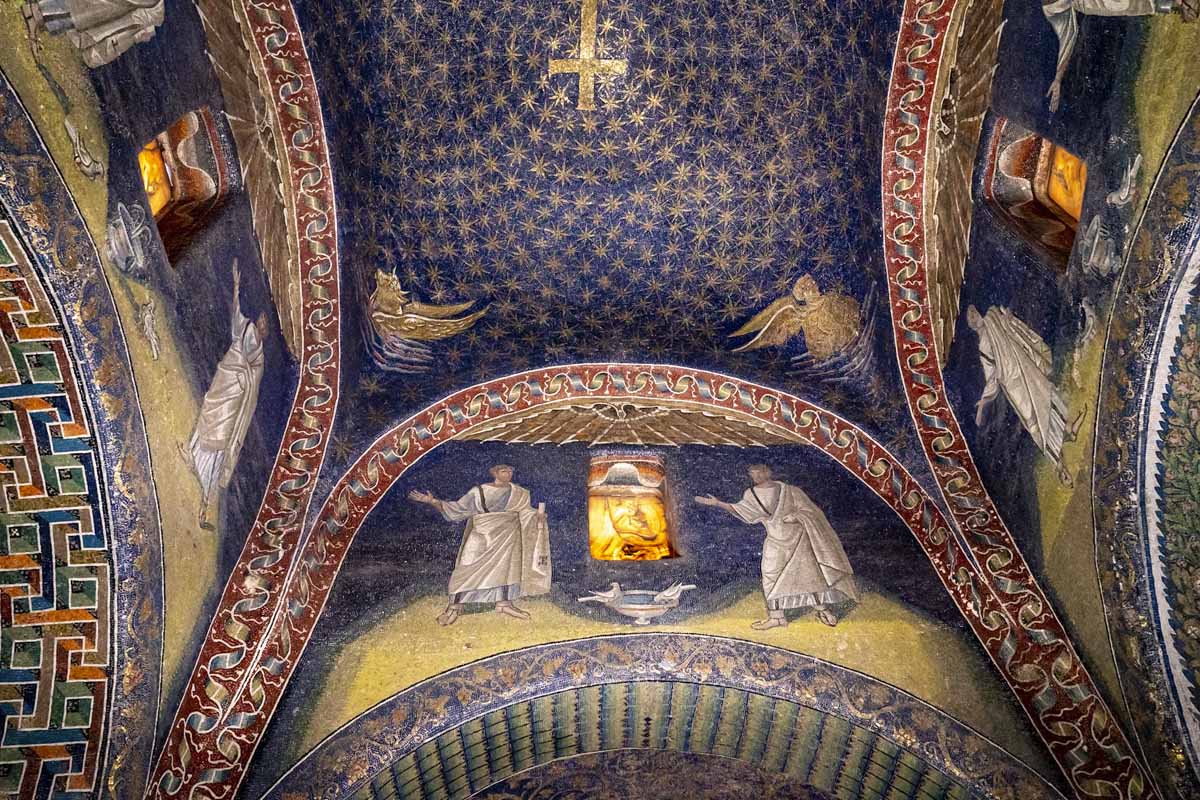
This tiny building, located just next to San Vitale, was supposed to become the resting place of Galla Placidia (the emperor’s sister), but it never was.
The outside looks very simple, but the inside will leave you speechless – a sky of blue tiles with golden stars covers the ceiling, while more mosaics decorate the walls. A golden cross is placed at the centre of the starry dome, in reference to the triumph of the cross over death.
The symbols of the four Evangelists surround the cross, symbolising the word of God reaching the four corners of the globe. Two more mosaics are worth a mention – a lunette representing the Good Shepherd just above the entrance, and another with the martyrdom of Saint Lawrence right opposite.
The lunettes on the left and right have mosaics of deer drinking at a pond, signifying holy water as a source of life.
The atmosphere in the Mausoleum of Galla Placidia is so magical that it inspired Cole Porter’s song ‘Night and Day’ – this one definitely deserves to be in your list of Ravenna mosaics worth visiting!
Basilica of Sant’Apollinare Nuovo
This church has a long history stretching back to the 5th century – it was built to be an Arian place of worship, and it became a Catholic church following Ravenna’s conquest by Justinian in the 6th century AD.
At that time, the church was dedicated to Saint Martin of Tours, defender of the Christian doctrine against heretics. It received the name Sant’Apollinare Nuovo in the 9th century, when the body of Saint Apollinare, the first bishop of Ravenna, was moved there from the Basilica of the same name in Classe.
The altar and apse of Sant’Apollinare Nuovo is Baroque – but if you look at the walls of the central nave, you’ll see dazzling golden mosaics depicting the life of Jesus Christ, plus two processions of Martyrs and Virgins.
However, the most interesting details in Sant’Apollinare Nuovo are the hands that you can see on the columns of the Palatium – they are a trace of the first decoration, that represented the emperor Theodoric and its entourage when the church was still Arian.
All Arian decorations were canceled and replaced with golden mosaic tiles, in an attempt to erase all evidence of the church’s former dedication.
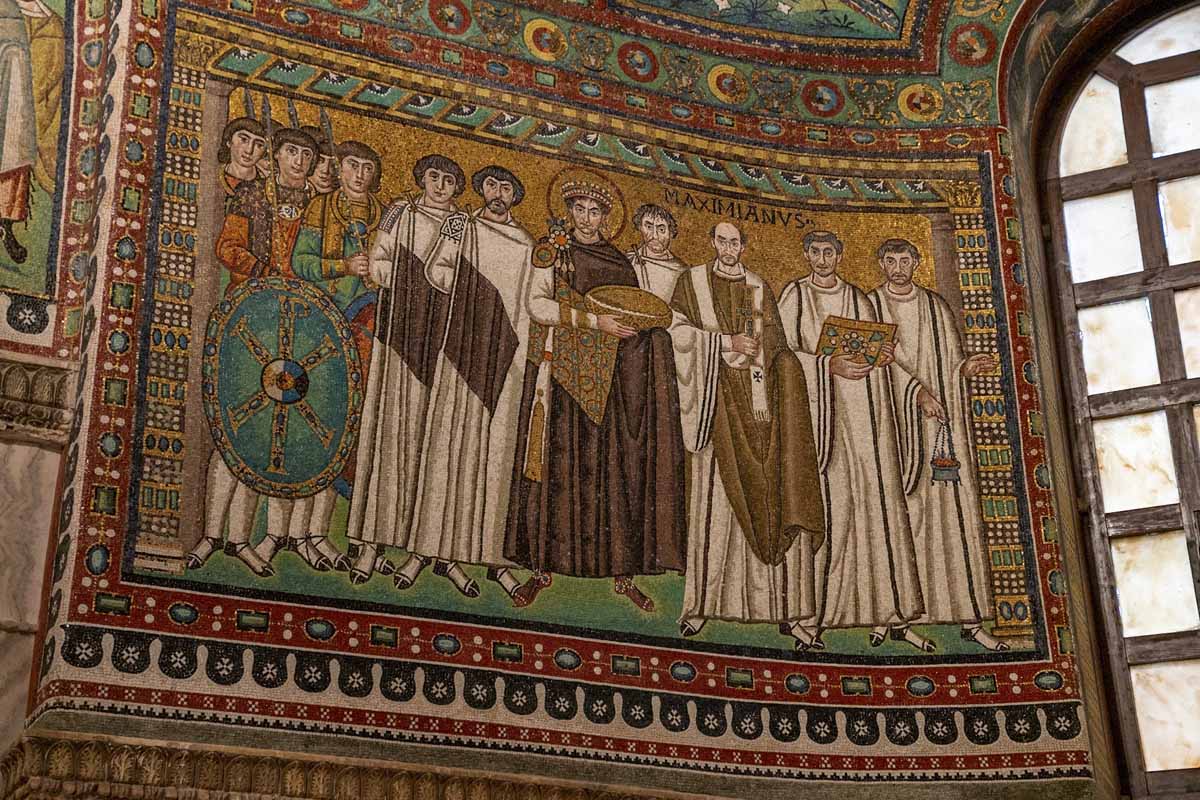
Baptistery of Neon
The Baptistery of Neon is a great example of mosaics with a Hellenic-Roman influence, in contrast with the Byzantine style found in most other Ravenna mosaics.
This is probably the earliest well-preserved baptistery building in the world, dating back to the 5th century. Blue and golden mosaics decorate the whole ceiling and the main theme represented is the Baptism of Christ, with a white dove and the personification of the river Jordan, depicted as a bearded man.
The baptism scene at the top of the dome is surrounded by representations of the Twelve Apostles, plus an outer ring with mosaics of architectural scenes, often seen in Roman mosaics.
Chapel of Sant’Andrea
Hidden inside the Archiepiscopal museum, this little chapel kind of looks like a summary of all the other points of interest with mosaics in Ravenna.
It’s really tiny, and not many people get to see it – but we think it’s really worth a visit for its starry golden sky and animal mosaics. This is a true hidden gem among Ravenna mosaics!
Basilica of Sant’Apollinare in Classe
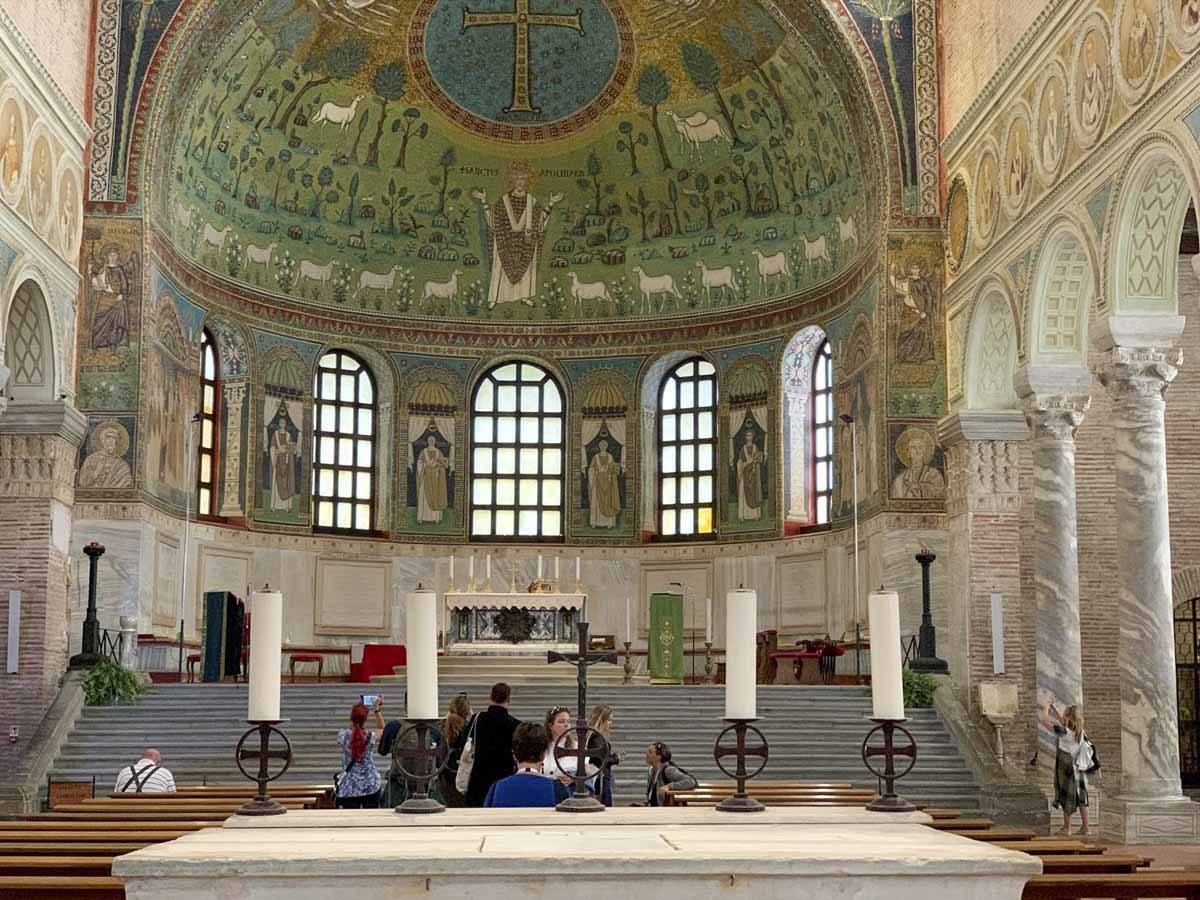
It’s time to leave Ravenna and travel 4 km outside of the city centre to Classe, the ancient port of Ravenna, housing two masterpieces – the Basilica of Sant’Apollinare in Classe, and the Classis Museum.
Sant’Apollinare in Classe used to house the remains of the saint of the same name until the 9th century, when they were taken to Ravenna to Sant’Apollinare Nuovo, to keep them safe from frequent pirate attacks.
Nowadays, the church is worth visiting for the spectacular Byzantine mosaics covering its nave and apse. The latter is especially dazzling – the uppermost part is golden and dominated by a bejeweled cross, with the effigy of God at its centre.
Two prophets are placed besides the cross, and the Hand of God is right at the top. The theme of the apse mosaics is the divine nature of Jesus, denied by the Arian doctrine.
The lower part of the apse represents a green, paradisiac valley with Sant’Apollinare at the centre, surrounded by plants, rocks, birds, and twelve lambs, symbolising the Apostles.
Classis Museum

Those wanting to know more about Ravenna and its history should definitely walk to Classis Museum after visiting Sant’Apollinare in Classe.
This recently-opened archaeological museum is worth a visit first of all for its striking architecture – it’s located in a former sugar factory, with a striking mosaic decorating the entrance staircase, reminiscent of a wave.
Classis Museum illustrates the history of Ravenna from its origin, all the way through to its time as capital of the Western Roman Empire and afterwards, up to the year 1000. Over 600 exhibits are on display, including examples of Roman mosaics.
Arian Baptistery
The Arian Baptistery is an octagonally-shaped little building. The inside is pretty basic in terms of architecture, but when you look up you will be amazed by its mosaic-adorned cupola, looking even more sparkling and amazing surrounded by the plain stone walls.
The Baptistery was built by Theodoric in the 5th century, when Arianism was the official religion of the court. In terms of iconography, it’s very similar to the Baptistery of Neon (yes, again – it’s a baptistery, after all), with the baptism of Christ at the centre of the dome, with an outer ring depicting the twelve Apostles.
Offbeat Ravenna Mosaics
Still haven’t had enough visiting ancient mosaics in Ravenna? Then I have two more places for you:
- Basilica of San Francesco
Get into the church and walk all the way down the aisle to reach the crypt. Put 1€ in the box and wait for it – magic is about to unfold. The floor of the crypt is covered in old mosaics and… it’s underwater! You may even glimpse some fish! - Domus of the Stone Carpets
One of the last archaeological discoveries of the city. Every room of this ancient palace had its floors decorated with mosaics, and you can walk above them on a glass boardwalk.
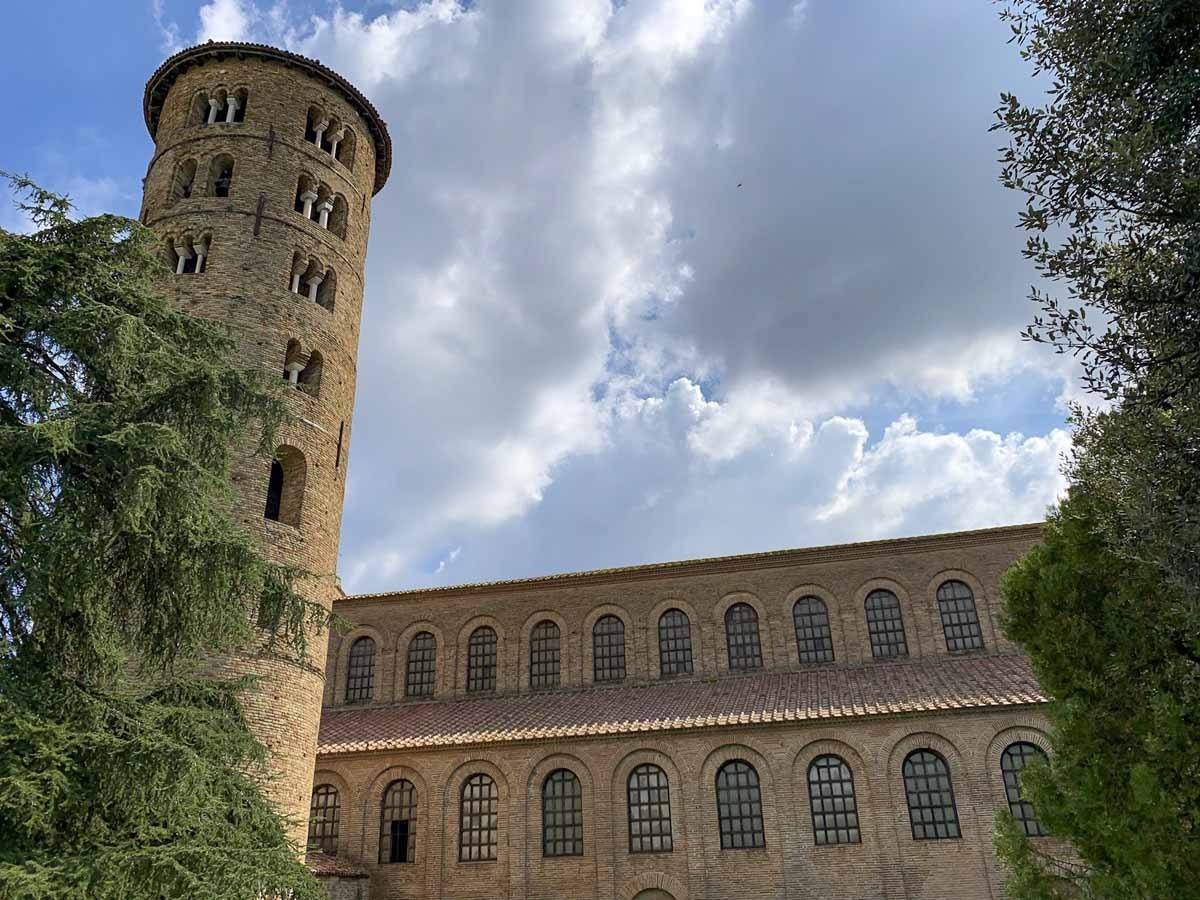
Modern Ravenna Mosaics
As I said in the beginning, Ravenna has a long, prestigious history, but this doesn’t mean it’s stuck in the past. The art of Ravenna mosaics also reached the 21st century, and if you love modern and contemporary art, you can find lots of modern mosaics all over the city – starting with street signs!
- TAMO – This museum, located inside a Medieval church, is the meeting point between ancient and modern mosaics. Here you can learn everything about this technique, including how Byzantine masterpieces were restored, and also see some contemporary pieces of art dedicated to Dante Alighieri.
- MAR Ravenna Art Museum – The main art museum in Ravenna also includes a sizeable exhibition of mosaics from the 20th century onwards, including some of the biggest names in the mosaic-making world and a variety of subjects. You’ll find mosaic renditions of art movements like constructivism, pop art, abstractism and postmodernism.
- Invader – This street artist literally invaded cities all over the world with its “pixelated” artworks. Ravenna was one of the sets of his Space Invader project: its streets host around 35 of these modern mosaics made out of ceramic tiles. You can find maps of them online, but the fun part is to unexpectedly discover them while you stroll around the city.
- Mosaic benches – At the dockyard of Ravenna and in the garden of Rasponi Palace you will find some benches covered in mosaics. They are probably not the most comfortable to sit on, but definitely picturesque: head to the dockyard at sunset to enjoy them.
- Ardea Purpurea fountain – Immediately out of the historical centre, in a quite featureless square, a beautiful monument stands tall – it’s Ardea Purpurea fountain, designed by Marco Bravura, a renowned mosaic artist of Ravenna. It symbolizes rebirth, reconstruction and search for harmony. Don’t miss it!
- Mosaic workshops – Do you want to take the mosaics of Ravenna back home with you? You can, if you visit the ateliers of local mosaic artists and purchase one of their pieces. To name three, you could opt for Koko Mosaico, Annafietta or Akomena Spazio Mosaico. You will find some unique souvenirs there, that’s for sure!
I hope you will enjoy your visit to this unusual and memorable Italian destination. Well, actually I’m pretty positive you will fall in love with Ravenna and its mosaics, just like we did!
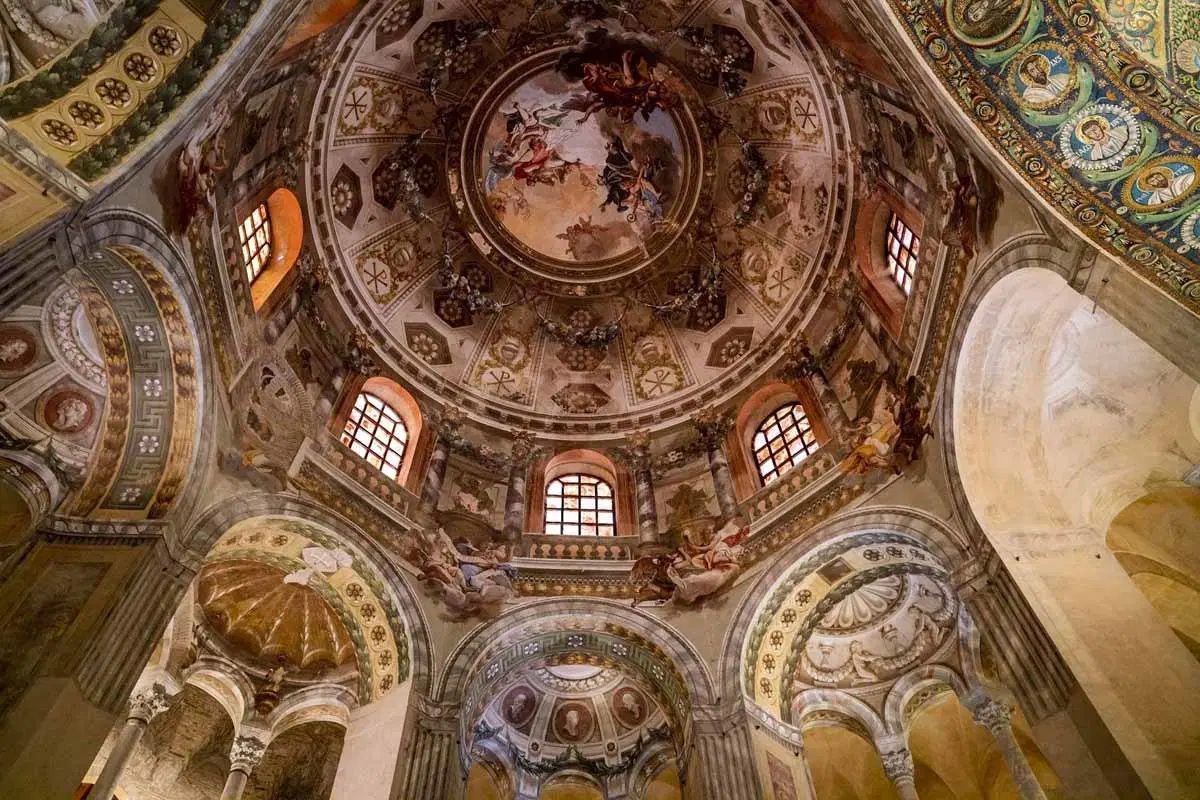
How to Get to Ravenna
- By Plane – the closest airports to Ravenna are Bologna (1 hour), Ancona and Venice (2 hours).
- By Train – if you’re travelling around Italy by train, your best bet would be heading to Bologna and connecting to a regional train. There are hourly departures, and travel time is 1 hour 15. Tickets cost €7.35 each way (as of Oct 2019).
- By Car – the closest motorway to Ravenna is the A14, connecting Bologna to Ancona and then following down the Adriatic coast. Travel time by car from Bologna is about an hour; it’s also possible to drive to Venice following the SS309 Romea, a scenic journey that also includes the Po Delta.
Best Time to Visit Ravenna
Ravenna is a year-round destination, and since most Ravenna mosaics are located indoors, the cold, rain, and/or extreme heat are not really an issue if mosaics are the main reason of your visit. However, Ravenna is also a wonderful place to walk around, and it’s located close to some worthwhile day trip destinations like Comacchio, a town on the Po Delta surrounded by canals, and Cervia on the Adriatic Riviera.
It’s not fun to explore Ravenna and surroundings when it’s really hot or really cold, so we recommend visiting Ravenna in shoulder season (March/May or September/October) to escape the summer crowds and enjoy mild weather. The rain is always a possibility, but there are plenty of mosaics and museums to see indoors!
Our time in Ravenna was sponsored by Turismo Emilia Romagna. We would like to thank iAmbassador and Ravenna Turismo for the wonderful experience.
